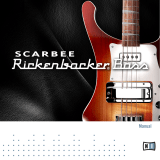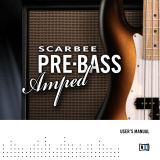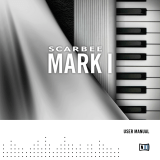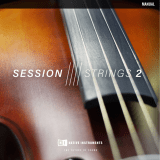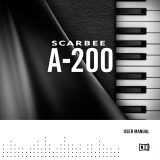Page is loading ...

USER’S MANUAL

The information in this document is subject to change without notice and does not represent a
commitment on the part of Native Instruments GmbH. The software described by this document is
subject to a License Agreement and may not be copied to other media. No part of this publication
may be copied, reproduced or otherwise transmitted or recorded, for any purpose, without prior
written permission by Native Instruments GmbH, hereinafter referred to as Native Instruments. All
product and company names are ™ or ® trademarks of their respective owners.
Manual written by Nils Liberg, edited by Patryk Korman
Document Version: 1.0 (08/2009)
Product Version: 1.0 (08/2009)
Special thanks to the Beta Test Team, who were invaluable not just in tracking down bugs, but in
making this a better product.

Germany
Native Instruments GmbH
Schlesische Str. 28
D-10997 Berlin
Germany
info@native-instruments.de
www.native-instruments.de
USA
Native Instruments North America, Inc.
5631 Hollywood Boulevard
Los Angeles, CA 90028
USA
sales@native-instruments.com
www.native-instruments.com
© Native Instruments GmbH, 2009. All rights reserved.

Scarbee MM-Bass – IV
Table Of Content
1 Foreword (by Nile Rodgers) ...............................................................................................6
2 Introduction ......................................................................................................................7
2.1 About the Bass ............................................................................................. 9
2.2 Thomas Hansen Skarbye – The Bassist and Producer ........................................10
2.3 Nils Liberg – Script Developer ........................................................................11
3 Playing Bass Notes on a Keyboard ................................................................................... 13
3.1 Automatic String Selection ............................................................................13
3.2 Manual String Selection ............................................................................... 14
4 Key Layout ...................................................................................................................... 15
5 Articulations ................................................................................................................... 16
5.1 Sustains, Mutes and Harmonics .....................................................................16
5.2 Hammer-on / Pull-off ....................................................................................16
5.3 Fast Grace Note Up ......................................................................................17
5.4 Slides .........................................................................................................17
5.5 Buzz-trills, Trills ...........................................................................................18
5.6 Trill Tails .....................................................................................................18
5.7 Pickup Clap .................................................................................................19
5.8 Automatically Triggered Samples ....................................................................19
5.8.1 Release Samples ............................................................................ 20
5.8.2 Pickup-hits .................................................................................... 21
6 Playing Techniques .........................................................................................................22
6.1 Index and Middle Finger Alternation ............................................................... 22
6.2 Extended Hammer-on/Pull-off ....................................................................... 23
6.3 Cross Hammering ........................................................................................ 23
6.4 Chords ....................................................................................................... 24
6.5 Chord Slides ............................................................................................... 25

Scarbee MM-Bass – V
6.6 Percussive Slides ........................................................................................ 25
7 Sustaining Notes .............................................................................................................26
8 Vibrato ...........................................................................................................................27
9 Instrument Reset .............................................................................................................28
10 Main Menu and Instrument Settings .................................................................................29
10.1 Player Prole .............................................................................................. 29
10.2 FX Presets ................................................................................................. 30
10.3 EQ ............................................................................................................ 31
10.4 Vibrato ....................................................................................................... 31
10.5 Pickup Hit .................................................................................................. 32
10.6 Release .................................................................................................... 33
10.7 Chords ....................................................................................................... 34
10.8 Alternation ................................................................................................. 35
10.9 Noise Levels ............................................................................................... 35
10.10 Controllers ................................................................................................. 36
10.11 Help .......................................................................................................... 37
11 Differences Between MM-Bass, Pre-Bass, and Red Bass ...................................................38
12 Production Credits & Thank You’s ....................................................................................39

Scarbee MM-Bass – 6
1 Foreword (by Nile Rodgers)
When Thomas Hansen Skarbye rst approached me about doing a bass sound dedicated to
Bernard Edwards, naturally I was skeptical. Bernard’s sound is so distinctive and so elusive
that it seemed an impossible task. The rst time I heard Scarbee’s “MM-Bass”, I was stunned
at how good it was, and how much it evokes the spirit and the sound of CHIC’s vibe. It was
clear that Thomas’ passion and dedication to his craft, to the bass guitar, and to the legacy
of Bernard Edwards was very profound, and that he had created something truly remarkable.
We have recently been working on a number of projects that have 70’s and 80’s classic
sounds. From a new Will Ferrell movie to some next generation music video games. MM-Bass
software helps us to achieve a sound and feel so close to “classic”, that I expect we’ll be us-
ing it for many future projects.
SPRACHE IN Paragraph-Style “05 - STANDARD Fließtext” passend einstellen
Nile Rodgers, founding member of Chic, world renowned producer,
musician, guitarist, and songwriter about the MM-Bass D.I.

Scarbee MM-Bass – 7
2 Introduction
The Scarbee MM-Bass was recorded with atwound strings to get the warm and creamy
sound of the 70s disco and funk bass lines, and D.I. to give maximum exibility in the sound
production. It features an extensive set of playing techniques, for example:
• Sustains
• Mutes
• Harmonics
• Hammer-on & pull-off
• Fast grace notes
• Slides (in most any speed you could want)
• Trills
• Buzz-trills
• Cross hammering
• Chords
• Chord slides
• Percussive slides
• Index and middle nger alternation
• Multiple sets of release samples: loose, tighter and tight.
MM-Bass was designed to make it very easy to use all these while playing live. Except for
the trills and cross hammering you can trigger all of the articulations and techniques above
without the need for any key switches.
The full strings of the bass have been sampled in order to reproduce the timbre changes that
occur when you move between low and high frets on the string of a real bass. This results in
a very rich sound with all the natural overtones.

Scarbee MM-Bass – 8
It should be noted that MM-Bass is much more than just a collection of samples. It features
a sophisticated script which takes care of many things automatically for you, for example:
• String selection
• A fretboard display updated dynamically as you play
• Alternation between index and middle nger
• Chord recognition
1
• Random alternation between three different types of release samples
• Random insertion of pickup hits
2
Furthermore, the script enables you to congure all settings including EQ, load and store FX
presets, and access documentation covering every aspect of the instrument directly through
the instrument performance view.
1
Ensures correct string selection even if the chord notes don’t arrive at exactly the same time, and that the
base note of a chord is played with index nger while the other notes are played with middle nger samples.
2
Not completely random because it is intelligent enough to take into account on which strings/frets and
for which velocities pickup hits are most likely to occur.

Scarbee MM-Bass – 9
2.1 About the Bass
Since we have no special agreement with the company that manufactured the sampled bass we will not
mention the trademarked name or show pictures of the bass. However, the instrument we used was an
excellent and expensive american bass - an updated but classic sound.
The truth is I didn’t use the exact same bass as we knew was on the beloved recordings from the 70s. I
know exactly what bass was used on songs—and that the strings were totally worn-out roundwound strings,
but when you deal with sounds your ears are more important than pure facts.
The songs had sometimes been through more than one mastering session and the sound of the instruments
changed for each mastering. Therefore the bass sound I was looking for was the one I heard out of the
speakers—the processed sound. So by using an updated version of the original bass—which has a mel-
lower tone as body is smaller, pickup magnets are Ceramic (original bass had Alnico magnets) and preamp
different, and by using atwound strings, I managed to get much closer to the sound I wanted and loved.

Scarbee MM-Bass – 10
2.2 Thomas Hansen Skarbye – The Bassist and Producer
When I was a boy, I wanted to be a great Magician, I wanted to amaze the audience and
leave them wondering: “How did he do that?“ Years later, I am still very fond of “illusions“
in any media. I watch almost every movie that raises the bar of Special Effects and I share
true interest in computer and console games with my sons for the same reason. These days
my magic wand and top hat are the Scarbee Sample Libraries.
I have played in various funk bands as a bassist during my younger years, but started soon
to compose music for TV documentaries and aimed for a career as a lm composer. After
composing, producing music on more than 150 commercials for TV and Cinema (even work-
ing with Oscar winning director Bille August), I began to create Sample Libraries and Virtual
Instruments as I wanted better sounds to use for my productions. These products are used
by top artists around the world on albums and live.
Due to “Carpal Tunnel Syndrome“ (weak wrists) I invented an articial way of playing bass
using software in 1998 and released the Scarbee J-Slap & J-Fingered in 2000.
Originally planning a fretless bass release, I instead decided to take a break from the basses
and do some “easy“ vintage keyboard sounds to use in my productions. Ironically it took me
5 years to complete the Vintage Keyboard Collection and the Vintage Keyboard FX plugin!
Not exactly an easy job as I expected, but this is me in a nutshell; I go into something, dig
deeper and deeper and slowly revealing the secrets and soul of the instrument and can not
stop until the job is done.
The MM-Bass project started in 2005 with the rst sound recordings. Four versions was
dumped before I nally found the right bass, strings and playing position. I wanted to nd the
sound that was closest to my identity as I had been searching all my life for the right sound—
playing various bass brand in the world—with no luck. When listening to all my favorite bass

Scarbee MM-Bass – 11
lines from the 70s, I soon realized that it was the same sound I came back to. It was a bass
I never imagined I would own as it was too expensive when I was a young player and at that
time I wasn’t that crazy about the ngered sound, more the slap sound. However, one evening
I decided to put a set of atwound strings on the bass to get a warmer, burning tone, and
while experimenting with the right hand playing position I suddenly felt “it”: I instantly fell in
love with the sound my ngers were producing—both the ngered and the slap sound—and
I knew I had to create yet a piece of bass software, this time even better in any way.
Personally I prefer to play hard on it to get the growl and aggressive tone, but it can also play
gentle and soft. The amount of expression is the reason why this sound is one of my favorites.
Scarbee MM-Bass is my personal tool, that I use in my work for other artists and in my own
productions, so I will keep on updating it for the time to come, making extra details, slapped
sounds etc. This will denitely benet you as a user.
Please enjoy our bass, we sure put a lot of love in it!
I now give myself more time to compose and rene my vocal work as well, so please keep an
eye on www.myspace.com/scarbee where I will post some of my songs.
2.3 Nils Liberg – Script Developer
I was contacted by Thomas in the autumn of 2006 to create a Kontakt 2 script for what would
later become MM-Bass. What initially seemed to be a small utility script for interval samples
that I planned to implement in a day or two soon grew into something much bigger. Together
we came up with ideas such as automatic string selection, easy ways to trigger grace notes
and chord slides without keyswitches, and how to implement slides in all different tempi while
keeping RAM usage down.

Scarbee MM-Bass – 12
It was a very fruitful cooperation—me focusing on providing the user with the best possible
interface in both musical and visual respects, and Thomas fully devoted to capturing the sound
of not just the instrument but what it can sound like in the hands of a really good bass player.
It has been a privilege to follow Thomas during this time—frustrating the times he decided
to suddenly discard all the samples he’d recorded the week before because they didn’t live
up to his high standards, but in the end a pleasure to work with someone with such a feeling
for both detail and the bigger picture.
My goal with the MM-Bass script has been to make the instrument so easy to play that the
user will never feel it’s too much trouble to use any of the articulations. It feels doubly reward-
ing to have been able to put all my creativity into something that I know will nally be used
as part of and benet another person’s creative expression. It is my hope that you will nd
MM-Bass an inspiring instrument to use.
Nils Liberg is an experienced script developer and is the author of a widely used script de-
velopment environment for Mac/PC.

Scarbee MM-Bass – 13
3 Playing Bass Notes on a Keyboard
With stringed instruments a certain note can often be played on multiple strings, and so the
player has to choose. For example, G2 can be played on all four strings of the bass with each
string having its own very distinctive sound. Many sample libraries and virtual instruments
take the simplistic route of recording only one sample per note (from the lower playing posi-
tions), which means that the user gets a very limited instrument.
MM-Bass on the other hand includes samples of all the different strings each note can be
played on, thus capturing the sound of the whole instrument. In our view the samples at
higher frets is an integral part of the instrument and adds spice and variation to the sound.
When a real bass player is about to play a note he/she typically chooses the string on which
the note can be played with minimum effort. That is, without moving the left hand too much.
On a keyboard it’s difcult to manually perform this string selection in real-time and laborious
to do it after recording, so we came up with a way to let the MM-Bass script do it for you.
3.1 Automatic String Selection
The gure below shows the main view of the instrument user interface. Note the white dotted
line above the fretboard. It represents the position of the left hand on the bass neck—the
playing position. When you play a note on the keyboard, MM-Bass automatically chooses a
string that minimizes the need to move the playing position (the left hand), similar to a real
bass player. This way you can get the full sound of the bass with minimum effort. I.e. if you
play an octave interval, the correct strings will automatically be used.
That’s the basic operation, but the automatic string selection also takes many other things into
account such as when to use open strings and what special rules to use for each articulation.

Scarbee MM-Bass – 14
Articulation specic symbols are displayed on the fretboard on the selected string/fret as
shown above, and the text label below the fretboard shows the name of the last used ar-
ticulation. Each string is monophonic so a new note interrupts any earlier one on the same
string—just like on a real bass. Simply trying out MM-Bass oneself is perhaps the best way
to understand how it works.
3.2 Manual String Selection
It is also possible to control the string selection manually. Each string has an associated key
switch: E0, A0, D0, G0—picked to be easy to remember. In MM-Bass a key switch affects
the following note or remains active for as long as you hold it pressed. To return to the normal
mode of operation just release the key switch. It is possible to combine more than one string
key switch. For example you can hold A0 and D0 pressed simultaneously to make A and D
be the preferred strings.
Another way of controlling the string choice is by using key switches F5-B6 to specify which
frets you prefer. The F5 key corresponds to the rst fret, F#5 to the second fret and so on.
To make it easier to learn we made the fret key switches match the corresponding note on
the E-string of a bass (F is the rst fret on this string, F# the second and so on). By pressing
and releasing one of these key switches you move the playing position and at the same time
trigger a fret noise sample (different noises are used depending on how far you move). You
can also lock the playing position by holding one of these key switch pressed while playing.
As will be shown later it is also possible to use a MIDI Controller for fret selection.

Scarbee MM-Bass – 15
4 Key Layout
Here is a schematic of the keys in MM-Bass. The red keys are key switches and the blue
ones mapped to normal samples
1
. This is just an overview. Instructions on how to use each
key switch and what it does is given in the following text sections.
Keyswitches Normal bass
Playing Position Keyswitches
(F5 TO B6 tret 1 to 20)
Sustain (A-1)
Mutes (A#-1)
Reset (B-1)
D string (D0)
C string (C0)
B string (B0)
A string (A0)
Buzz-trill / Trill (G#0)
Extended hammer-on/pull-off (F#0)Index finger (F#0)
Pickup hit and tight release toggle (F0)Middle finger (C#0)
Chord mode (D#0)
Pickup clap (A#0)
Fingered*
Slap
Lead
Finger-picking
*only Fingered is available at this point.
The others represent possible future extensions
1
The bass has no B string, but for exibility the notes B0 to D#1 have been mapped to a virtual B string.
These notes use stretched E string samples. Only basic articulations like sustain, mutes, hammer-on and
pull-off are available on the virtual B string.

Scarbee MM-Bass – 16
5 Articulations
5.1 Sustains, Mutes and Harmonics
Sustain is the default articulation. For velocities below 40 you get mutes instead, and for
velocities below 15 you get harmonics where available and mutes otherwise. Enough veloci-
ties layers have been recorded to achieve natural transitions from soft to hard playing. Please
note that harmonics are mapped to the string/fret where they are played on a real bass and
not to the pitch of the sound.
If you activate the mutes key switch (A#1) you will get mutes irrespectively of the velocity.
This can be used to make it easier to trigger mutes since you do not need to rely on getting
the right velocity when using it.
5.2 Hammer-on / Pull-off
Legato
To trigger a hammer-on or pull-off you simply play a half- or whole
note either down or up legato (overlapping the earlier note). If a
hammer-on or pull-off is not available (eg. when playing a note le-
gato downwards from fret 1) you will get a sustain instead.
Hammer-on / pull-off for intervals greater than 1-2 semitones may
be played by activating the F#0 key switch. See more about this
further down.

Scarbee MM-Bass – 17
5.3 Fast Grace Note Up
Fast Legato
A fast grace note is triggered in the same way as a hammer-on,
one needs to play the legato note very quickly after the previous
note. Eg. play a C2, hold it pressed and press a D2 quickly after
(between 20 and 60 milliseconds).
The velocity of the lower note—the pre-hit note—is used as the
velocity for playing the fast grace note sample. This allows you to
play the second note at any velocity, which can help because one
often ends up hitting it a bit harder since it has to be triggered so
fast.
It was an old dream since the year 2000 to be able to trigger fast
grace notes in an intuitive way and now it has nally come true –
no key switches are necessary!
5.4 Slides
Legato
+
Slides are available in speeds 60 to 480 bpm. Play a note legato
while holding the sustain pedal pressed to trigger a slide. If it’s not
possible to slide the played interval without going outside of the
available frets a sustain will be used instead. The velocity of the
target note determines the speed of the slide. There are three re-
corded slide tempi:
Velocities 1-30 trigger the slowest slide sample (60 to 89 bpm)
Velocities 31-60 trigger the middle slide sample (90 to 119 bpm)
Velocities 61-127 trigger the fastest slide sample (120 to 480 bpm)
The beats per minute (bpm) tempo numbers above refer to the du-
ration of a 1/4 note in that tempo. To play a 1/8 note slide in tem-
po 120 you need to use a slide note velocity which corresponds to
240 bpm, and to play a 1/16 note slide (very fast) in tempo 120
you will need a velocity which corresponds to 480 bpm.

Scarbee MM-Bass – 18
5.5 Buzz-trills, Trills
A buzz-trill is the sound of a real bass player moving his nger
back and forth over a fret quickly. A trill on the other hand is a se-
quence of repeated hammer-on and pull-offs. Buzz-trills and trills
are activated by pressing the G#0 key switch. Buzz-trills are avail-
able on the D and G string and trills on the G string.
•
Velocities 1-59 give trills on G string and long buzz-trills on D
string.
• Velocities 60-89 give long buzz-trills
• Velocities 90-127 give short buzz-trills
Note that unlike the other key switches G#0 only affects the follow-
ing note even if it were to be held pressed. We made it like this to
make it easier to trigger a single trill without accidentally affecting
other notes.
5.6 Trill Tails
+
Legato (down)
Trill tails are based on the same samples as trills except that their
attack has been removed in order to make it possible to use them
after any other articulation—as a tail. They are available on the G
string.
To trigger a trill tail press the G#0 key switch to activate trill mode
and then play a pull-off (a half or whole note legato down). Please
note that the key switch must be pressed just before the pull-off
note and not earlier or you will get a trill or buzz-trill instead of a
sustain on the preceding note.
Here’s an example of how a trill tail can be performed: play A3 and
hold it pressed, play the G#0 key switch, play a legato down to G3.
The G3 legato note is played back as a trill tail.

Scarbee MM-Bass – 19
5.7 Pickup Clap
Play A#0 to get the sound of a pickup clap. Please note that A#0
behaves more like a normal note than a key switch—the A#0 itself
triggers the sound and it does not affect other notes. As many as
27 different pickup clap samples are included.
A real bass player typically hits the pick-up with his/her right hand
on snare drum hits (2/4) to keep the beat—or as some advanced
players: hit the pick-up as a aminco guitarist in between notes for
a funky, unique bass groove.
5.8 Automatically Triggered Samples
Included in MM-Bass are a number of samples which are automatically played back at cer-
tain times. In the settings you can congure what types of samples you want to use and how
often you want them to be played. Detailed explanations of how to make these settings can
be found later in this manual.

Scarbee MM-Bass – 20
5.8.1 Release Samples
▲
Toggles loose/tight
A release sample is played whenever a note is released. With one
exception: when a note is played legato (overlapping the earlier
note) a release sample is not played for the earlier note. There are
three sets of release samples:
• loose
• tight 1
• tight 2
The loose samples are noisier and adds character to the sound.
Tight 1 is a more tightly played type of release which is less promi-
nent and cleaner. And nally, tight 2 is similar to tight 1 but even
more cleanly played and is the least noisy of them all. In the settings
you can setup how often you want to hear each one of the types.
So which type should one use then? Well, it depends on the style
and what kind of bass player one wants to imitate. The profes-
sional and often hired studio musicians usually have a very ne
dampening technique—so you rarely hear the releases—even when
they are playing fast. These bass players, who you hear on so many
albums, mute the strings with a combination of the left and and
right hand to avoid ringing and other noise from the bass.
However, even they sometimes decide to play a bit more relaxed
and then you will hear more of the release sound. In more rock ori-
ented songs you will play much more relaxed and even appreciate
the raw sound of loose dampening.
In the settings you can specify whether you want all three types of
release or just the tight ones by default. The F0 key switch can then
be used to switch from the default mode to the non-default mode.
/

